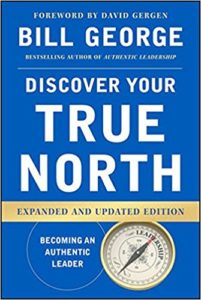30 Jan Your leadership purpose
In blogging about your leadership purpose, I declare I am a fan of Bill George’s well-known book True North: Discover Your Authentic Leadership, first published in 2007 (pictured). While I agree with George that strong values, personal integrity and a strong sense of self are fundamental to effective leadership. In my view, these traits are necessary, but not sufficient, for you to be a truly great leader.
While thinking about individual leadership on behalf of some of my high-performing clients, I came across ‘From Purpose To Impact’ a Harvard Business Review article by Nick Craig and  Scott Snook. ‘From Purpose to Impact’ extends ‘True North’ by adding the notion that having a clear personal purpose is the key to exceptional performance and well-being as a leader.
Scott Snook. ‘From Purpose to Impact’ extends ‘True North’ by adding the notion that having a clear personal purpose is the key to exceptional performance and well-being as a leader.
Clarity of personal purpose enables a leader to navigate the complex, ambiguous and ever-changing world, whether in the private or public sectors.
Somewhat surprisingly, they cite evidence that only about 20% of leaders can express their own individual purpose distinctively and convincingly. And even fewer can state their purpose in a classic elevator statement.
And perhaps of even more concern is their research showing that very few of those with a real purpose have a plan for translating it into actions that matter, i.e. have a meaningful impact.
Leadership purpose defined
Your leadership purpose is what you are driven to achieve and deliver. It’s embodied in your personal brand, which means it defines who you are and what makes you distinctive.
Here’s an example of purpose when thought about in this way:
“My purpose is to transform teaching and learning in my discipline so that the very best students anywhere in the world can access our subjects and be awarded a degree”.
My client is a professor in a leading, campus-based university. This statement of personal purpose builds on her passion, global standards and recognition in her discipline, and interests in all things digital. It is distinctive to the point where if in the appropriate company you were to ask who is described in the italicised sentence above, all would be able to name her.
What purpose is not is a brief summary of that part of your resume that sets out highlights of key career achievements or your title and qualifications.
How to discover your leadership purpose
Like many aspects of personal development, discovering your purpose sounds easy. It’s not!
The first stage of discovering your purpose involves working through your life and career to locate common themes that reflect your core strengths (your signature competencies), your values (those things to which you turn when making very difficult decisions) and passions (those activities that set you alight with energy). Craig and Snook recommend three prompts to help you do this:
-
- “What did you especially love as a child, before you realised the world is full of ‘shoulds and shouldn’ts’?
- Describe two of your most challenging life experiences. How have they shaped you?
- What do you enjoy doing in your life now that helps you sing your song?”
It’s best, they recommend, that you work through these questions with a few peers, your life partner and/or others close to you. Remember the words of the Scottish poet Robert Burns to the effect that You can’t see yourself as others do. The words in your purpose statement must be yours and they must call you to action.
Putting purpose into action
Question: How will you know if you are succeeding in living your leadership purpose? For what outcomes are you striving?
Answer: By preparing and executing a purpose-to-action plan. Start with your purpose statement; this is your touchstone. Take a whole of life-career perspective by focusing on your strengths to achieve career aspirations. Set incremental objectives: small steps that allow you to progress your purpose while still being able to flex as external circumstances change. Keep looking forward, the past is the past. Do it your way; leave your fingerprints on everything you touch. And be holistic: include family, social life, hobbies and career to be a better, bigger you. Finally, break your plan into short-, medium- and longer-term chunks, i.e. objectives and tasks, that cumulatively build on each other.
Conclusion
While most executives know the importance of a compelling vision or purpose statement (one of my Australian favourites is NAB’s “We back the bold”), the crucial role of individual leadership purpose statements is much less understood, let alone practised.
 As a psychologist, I know a clear personal purpose is a central part of the path to all-round well-being. The great Viktor Frankl, a survivor of a WWII concentration camp, wrote Man’s Search for Meaning on this very topic, first published in 1946.
As a psychologist, I know a clear personal purpose is a central part of the path to all-round well-being. The great Viktor Frankl, a survivor of a WWII concentration camp, wrote Man’s Search for Meaning on this very topic, first published in 1946.
And, increasingly, medical science is showing a connection between purpose and health in physical and mental senses, including increased longevity and reduced morbidity (see this recent paper, for example).
The rewards for developing and living your personal statement of purpose are rich, for you and your organisation.
Start today.


